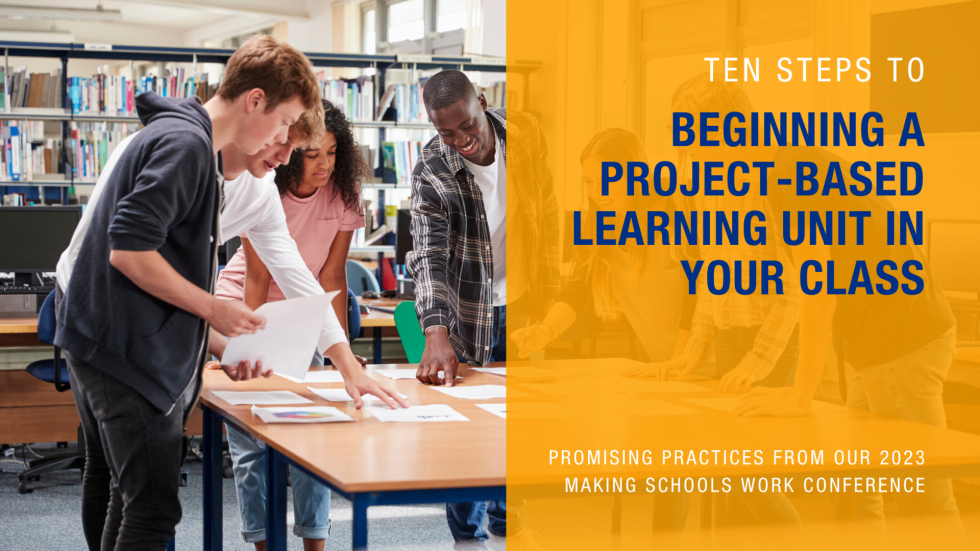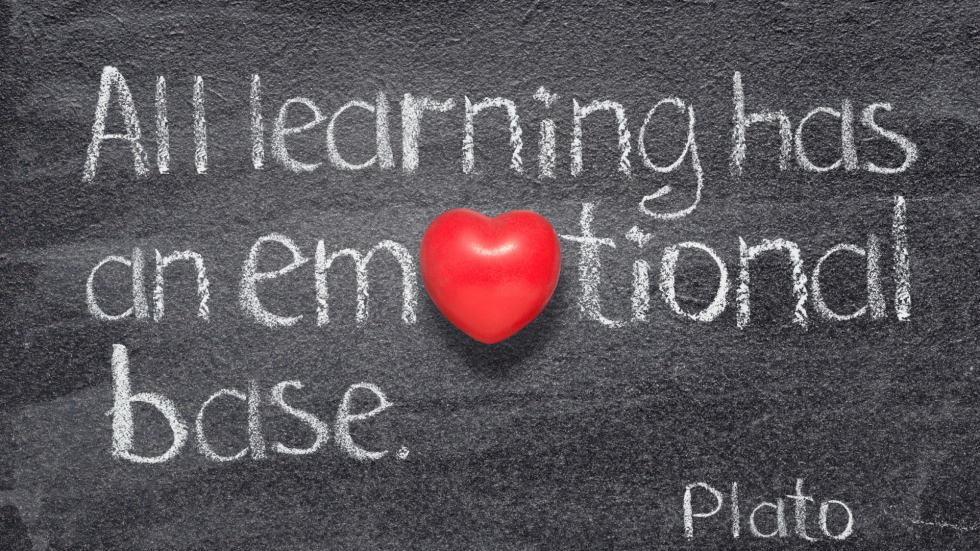Project-ing Your Teaching: 10 Steps to Beginning a Project-Based Learning Unit in Your Class
Prefer to listen? Check out the audio recording of this post instead.
Let’s start this by stating a hard truth: Even when you may want to do something new in your classroom, it can be hard to know where to start. Then, add into that uncertainty the fact that you’ll need some coaching, resources, planning, etc., and it can sometimes seem easier to keep doing what you are doing instead of trying out the new thing.
After all, why fix it if it ain’t broken?
The truth is, though, that for many students and teachers, the old way of doing things is broken, and so we do need to consider some updates to our teaching methods to ensure we are engaging our students to the highest level possible.
This is where project-based learning can transform the way we engage our students.
Project-based learning has students master content by doing some or all of the following:
- Successfully developing a solution to a problem.
- Answering a question.
- Developing a product.
PBL-based units of study can make a huge difference in the learning process of all of your students, but just like with anything new you do, it can be hard to know where to start.
This was the focus of my presentation “Always Wanted to Try Project-Based Learning, But Not Sure Where to Begin?” at the 2023 Making Schools Work Conference.
In this post, I’ll give you some insights into why PBL works and how you can start using it in your classroom.
What Is Project-Based Learning?
I should clear something up before I get too far into this:
PBL is not just a project you do at the end of the unit. It’s the central framework.
True PBL is integrated into your whole classroom. It’s the meal – not the dessert.
Here are some things to know about PBL:
- It encompasses both the knowledge and skills portion of the learning process.
- It leads to more engaging lessons.
- It utilizes more of the brain and is, therefore, more cognitively demanding.
- It includes both formative and summative assessment measures.
Have I convinced you that PBL is a great teaching method yet?
If so, let’s start thinking about how you can get started!
How to Begin a PBL Unit
No matter what you teach, you’ll be able to use these steps to start designing a PBL plan for your class.
Step 1: Select the Standards
Just like with any other teaching method, you’ll want to start by taking a look at the standards you’ll be teaching.
Start by asking yourself some general questions:
- What do you want your students to know/be able to do?
- What topics do you know they struggle with already?
- What topics do not work as well when taught traditionally?
- What topics would you be embarrassed about if your students couldn’t have an intelligent conversation about them at the end of the course?
The answers to the above questions will typically steer you towards content that will work well in the PBL building process. Knowing what standards you want to teach with the unit of study is essential and the first step in planning the PBL-based unit.
Step 2: Start Brainstorming Authentic Ideas
We are going to talk more in-depth about how to plan your project in step five, but for now, start thinking about ideas for what your project can be.
Consider some of the following questions as you plan:
- What is happening in your community? State? Country? World?
- What is going on in the news?
- What are your students into?
- What are you interested in?
- What material or content evokes emotions in your students? What makes them mad, glad, happy or sad? When content evokes an emotion, it naturally connects our minds to the learning and will ensure content is remembered long after the unit is completed.
The answers to these questions will help you determine a useful, interesting real-world problem that you can design a project-based unit around.
Step 3: Decide the Scope of the Project
Once you know what you want the students to get out of the project, it’s time to start narrowing in on the scope. This means things like how long the unit will last, how many standards it will cover, the tools they will have to do the project, who all will be involved and who the project is for.
Let’s look at an example of two different projects: a small project and an ambitious one.
| Small | Ambitious | |
|---|---|---|
| Duration | 5-10 days | 4 weeks-semester |
| Breadth | 1 topic/1-2 standards | Multiple disciplines/Multiple standards |
| Technology | Limited | Extensive |
| Outreach | Classroom-based | Community-based |
| Partnership | 1 teacher | Multiple teachers and community members |
| Audience | Classroom or school | Expert panel |
Let’s break this down a little more.
Determine Your Timetable
How do you know how long to give students? Partly, you’ll know how long you have in the semester to dedicate to the standard(s) that the PBL unit is teaching.
However, there are other things to consider, and some of them might mean that you come back to this part after you have the project in mind. I will talk more about this when we get to the sixth step.
Step 4: Know the Driving Question
What is the driving question behind your project? What are students striving to answer? This is an essential piece of the puzzle, and it can be the hardest to come up with.
With that in mind, start coming up with the overarching question, which should be all or at least most of the following criteria:
- Provocative
- Open-ended
- Integral to the discipline
- Challenging
- Real-world focused
- Standards aligned
- Thought-provoking (makes you go Hmmmmmm)
Here are some examples that I shared in my session:
- Do music videos paint an accurate picture of America?
- How safe is our water?
- How might we build a new community center using only materials that are native to our state?
- Should the US have used the atomic bomb in WWII?
Step 5: Designing Your Project to Ensure Authenticity
Okay. You now know the standards you are planning to teach, the scope of the project and the driving question you want them to be able to critically address at the end of the project. Let’s get to the fun part!
Once you are ready to start building your project, you will want to make it authentic. You can do this by aligning it to a real-world scenario.
Here is the template that I give to those designing a project:
|
You are a [Insert a real-workplace role]. |
|
You are faced with [Insert the circumstances and a problem]. |
|
You must [Insert what must be done to solve the problem]. |
|
Once you have decided on a course of action, you will [Insert an opportunity for presentation to an authentic audience]. |
You don’t need to use this exact template, but however you do it, try to address these four components.
Here is an example:
|
You are a construction manager. You and your crew are faced with using explosives to clear fallen rocks from a roadway, a task with many inherent risks—flying rock, premature detonation, vibration, air-overpressure and environmental pollution. Although the blaster is responsible for setting and detonating the explosives, safety is the responsibility of the construction manager and every member of the construction crew. You must research and read the appropriate set of OSHA regulations, understand the technical information it contains, and extrapolate the most important information. You will plan a “toolbox talk” for the construction crew to effectively convey the safety instructions and reinforce their awareness of the safety issues at hand. |
Helpful Hint: Always Keep Your Ending in Mind as You Design!
As you plan your project, make sure you keep the questions and standards that you created in the first few steps in mind as you go.
- Make sure your project has assessment measures that will lead to the learning objectives.
- Make your objectives clear.
- Tie everything to the standards.
- Ensure your formative assessments measures help you modify your teaching and support and measure student progress.
- Ensure your summative assessments are designed to give students the best chance to exhibit their knowledge and skills.
- Assessing for multiple indicators is better than just one indicator.
Step 6: Create Your Timetable
To determine your timetable, map out your project – what are the steps they will need to do and how long will it take to do them?
Here are some potential ways to do this and/or tips and reminders:
- Create a storyboard.
- Go component by component.
- Look at the tasks and activities you have planned.
- Consider the knowledge and skills that are needed.
- Create a Venn diagram.
- Use bubble charts.
- Break it down by days of the week.
Step 7: Plan Your Entry Event
Now that you have a project planned and ready to go, think about how you will introduce it to the class. How will you explain it and prepare the students for what comes next?
Entry events should engage students in a way that causes them to want to know more and ask more questions. Touching on emotions always helps students remember and engage on a deeper level.
Entry events can be as simple as a song, a movie clip, an article or a demonstration.
Authentic entry events may appear like a memo written from a manager to the employees charging them with a task. The more authentic the process, the less school-like the task will appear.
Step 8: Think About Classroom Management
Along with planning for the entry event, also take into account classroom management.
Will they be working in groups? I believe all projects should include group work, so, how will they be grouped?
I suggest ability grouping as the best method; it will allow you, the teacher, to focus your energy on the groups needing the most support and check in on the other groups less frequently but enough to keep tabs on their work.
- Some days you may want to use an expert group (one student from each group) to receive small group instruction and task them with teaching the others in their group.
- Some days you may choose to have the slower students observe the work of the faster groups.
- Some days you may want experts to be consultants with other groups.
Be creative! Think like the workplace and release your tendencies to keep control of all aspects of the learning.
Step 9: Make Sure Your Project Meets the Six A’s
Once you have the project ready to go, but before you have implemented it, check to make sure that it meets the six A’s. The six A’s were created by the Buck Institute many years ago but can still serve the purpose of helping us measure the quality of our work.
Where does your project stand on a scale of 1-10 on each characteristic?
- Authenticity – utilizes real-world context
- Academic rigor – addresses learning standards and helps answer big-picture questions
- Applied learning – has students apply knowledge and use work skills
- Active exploration – gives students a chance to interact with materials outside of class
- Adult connections – uses adult mentors/coaches from the wider community
- Assessment practices – determines criteria for measuring desired outcomes
A good project will rank a seven or higher on at least four of the six indicators. A great project, of course, will rank highly in all areas.
Step 10: Implement, Monitor and Adjust as Needed
Once you have your project ready, try it in your class!
Just like anything you do in the classroom, though, you should be prepared to monitor and make adjustments as needed.
Projects are built over time; sometimes the first time you implement a project you will not have every piece as finely polished as you would like. This does not mean it is a bad PBL experience for students; it just means there are areas you need to fine-tune, to make the project more engaging, more authentic, etc.
The best projects are typically honed over several implementations with monitoring and adjusting faithfully taking place each time.
Final Thoughts
PBL can be a great way to make learning fun while also making it more rigorous!
We hope these steps help you; we have a lot more PBL resources for you on the SREB’s PBL page.
Plus, you can find a lot more tips and ideas by signing up for our Promising Practices Newsletter.







